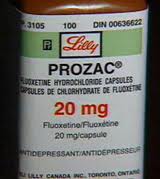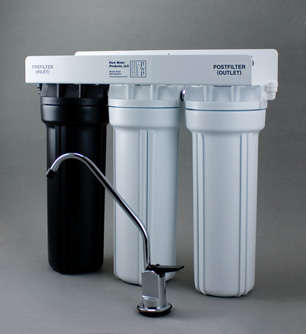In this new shorter-format end-of-May Occasional you’ll read about the water treatment practices of professional beverage makers, the advantages of multi-canister water filters, and the meaning and causes of Xerostomia. You’ll learn what Prozac has to do with bottled water sales and how viruses get into deep, deep aquifers. Read about Boron, how to get it out of water, and how it helped elect a president. And, as always, there is much, much more.
Lo bueno si breve dos veces bueno
The title is a Spanish proverb that means that when something is good, if it’s short, it is twice as good. We’ve decided to make the Occasional shorter and, we hope, better.
The Occasional was originally an “occasional,” then a monthly, then a twice-a-monthly. Starting now it will be a weekly, but the issues will be shorter. We hope you’ll like it better that way. We hope you won’t mind if we experiment with the format in coming weeks.
If you would like to read this issue on the Pure Water Gazette’swebsite, go here.
While you were fretting over your taxes and putting away your winter clothes, a lot of really interesting things happened in the world of water. You’ll find some of them below, but you’ll need to look for the rest in the Pure Water Gazette.
Recent Research Indicates That Viruses From Sewer Pipes Can Quickly Reach Deep Aquifers
It was previously believed that pathogens could not get into water wells that were sunk into deep groundwater aquifers. Now this is no longer accepted as a forgone conclusion. Over the past decade many disease-causing viruses have been found in very deep locations in both the United States and Europe.
Recent research shows that the viruses are in fact seeping into deep water wells from sewer pipes.
Most public water suppliers in the US do not test for the presence of viruses since the EPA does not require it. It was formerly believed, also, that it would take far too long for viruses to reach aquifers for them to survive. One writer explains, “Groundwater models predicted that surface contaminants would require tens to hundreds of years to reach wells in these aquifers, which typically sit more than 700 feet underground. Even if pathogens did find their way to the groundwater, they should be dead after that amount of time.” In spite of the “expert” predictions, viruses are being found in wells at very deep levels.
It was suspected that leaking sewer pipes are the source, and subsequent sampling seems to bear this out.
More than 147,000 public water systems in the US get their drinking water from underground aquifers, and most of these are not tested for viruses and many do not disinfect the water.
Reference: Chemical and Engineering News.
Xerostomia Can Be Traced to the 1,800 Prescription Drugs That Cause It, and Xerostomia Is What Drives Soaring Bottled Water Sales
Prescription drugs not only pollute water. They also make you drink more of it.
William Pentland, writing in Forbes, makes the case that the “blindingly obvious” reason that bottled water sales grew 7% in 2012 and have, in fact, grown steadily since the mid-1970s, is that people are thirstier than they used to be. And the reason they are thirstier, Pentland argues, is because of the prescription medications they take.
He writes that “. . . . [we are ignoring] the blindingly obvious reason why bottled water has become a boondoggle: Americans are thirstier than they used to be.
Xerostomia is the subjective feeling of having a dry mouth resulting from the dysfunction of the salivary glands.
Drug-induced xerostomia is a common side effect of over 1,800 forms of medications, including antidepressants, antihistamines, anticonvulsants and antipsychotics and other medications prescribed for high blood pressure, anxiety, allergies, weight loss, pain and so on and so forth. The more drugs a person takes, the more likely he or she will experience dry mouth.
The graph shows linear growth of bottled water sales between 1976 and the late 1980′s and then exponential growth during the 1990′s and 2000′s. Generally speaking, the pace of growth in bottled water accelerated with the introduction of antidepressants. In 1987, the Food and Drug Administration approved Prozac. By 1988, nearly 2.5 million prescriptions for Prozac were dispensed in America. In 2002, Prozac prescriptions had increased to more than 33 million. By 2008, antidepressants were the third-most-common prescription drug taken in America.
The American Academy of Oral Medicine prescribes the following treatment for people suffering from dry mouth: “Frequent sips of small amounts of fluids, especially water, can be quite helpful in diminishing the effects of oral dryness. Many patients keep a bottle of water handy to moisturize their tissues.”
Yes, they do.
Triple Undersink Filters Excel in Variety, Capacity, and Overall Performance
Black and White Triple Undersink Filter. Undersink filters require no drain connection and do not need electricity. They are easy to install and easy to maintain.
There are several reasons why multiple-canister drinking water filters are superior to single-vessel units. Here are a couple:
More Carbon
Filter carbon is the heart of all good drinking water filters. No matter who makes the filter, filter carbon is the essential ingredient because of its excellence at removing chemicals, whether they are disinfectants added by city water suppliers or the thousands of possible pesticides, herbicides, drugs, and petroleum products that are in the environment. It stands to reason that a double or triple filter with large 9.75″ X 2.5″ cartridges can hold a lot more filter carbon than tiny single-canister cartridge filters like Pur or Aquasana. In general terms, the “the more the better” rule is especially true when it comes to removing challenging chemicals like chloramines and volatile organics (VOCs). The more carbon, the more contact time the water has with the carbon, and the more effective the filter is.
More Variety
Standard-sized filter cartridges, especially the most standard of all, the 9.75″ X 2.5″, are available in many varieties and from many manufacturers. When makers of single canister units add specialty materials to remove contaminants like lead or arsenic it is at the expense of the carbon content. To add the specialty resin, they leave out some carbon. With multi-canister filters, full sized carbon filters are present even when specialty cartridges are added. Great variety in cartridge selection allows the filter user to customize the drinking water filter for his or her own water. With single cartridge systems it’s “one size fits all,” so you’re stuck with an “average” filter designed to do an average job on everyone’s water. A filter that does everything doesn’t do anything very well.
The table below contains a few of the many cartridges available in the standard 9.75″ X 2.5″ style. A click on the filter name will take you to a lot more information about the cartridge.
|
Part Number and Name
|
Filter Style
|
More Details
|
| FC001 MatriKX “CTO Plus”(formerly called KX-1). | 0.6 Micron Carbon Block, Bituminous Carbon | High Chemical Capacity. Great Chlorine and Chloramine reduction. Our favorite carbon block and standard cartridge for single filters and double filters. Incredible 20,000 gallon chlorine reduction capacity. |
| FC002.MatriKX “VOC” (formerly called KX-5). | 0.6 Micron Carbon, Block, coconut shell carbon. | High Chemical Capacity. Great Chlorine and Chloramine reduction. Especially good at VOC reduction. A popular cartridge that makes great tasting water. |
| FC004. MatriKX PB-1. | 0.5 Micron Carbon Block with Heavy Metals Resin added. | High Capacity Chemical Cartridge, also removes lead and heavy metals plus cysts (giardia and cryptosporidium). A long-time favorite for single and double filters. |
| FC027. Pentek Chlor-Plus 10. | 1 Micron Carbon Block. | Pentek Chlor-Plus 10 one-micron Carbon Block, designed especially for Chloramine Removal. 2,500 gallons of chloramine reduction at 0.5 gpm–1,000 gallons at 1.0 gpm. |
| FC008. PWP KDF1.5 GAC | Granular Coconut Shell Carbon with 1.5 lbs. of KDF 55. | Our own KDF drinking water cartridge. Long-term dechlorination, lead reduction, and excellent taste/odor improvement. |
| FC011. PWP Fluoride Reduction Cartridge. | Granular Activated Alumina Cartridge, made with Resin-Tech’s SIR-900 Fluoride Resin. | Our high quality fluoride cartridge made with the purest activated alumina. Also removes arsenic and lead. |
| FC708. Doulton Imperial Super Sterasyl | Free-Flowing Ceramic Cartridge with granular carbon core. | Doulton Imperial Super Sterasyl open end cartridge. Large diameter Super Sterasyl—ceramic/silver outer shell with granular carbon core for chemical reduction and taste/odor improvement. Removes bacteria, cysts, chemicals. |
| FC020. PWP Centaur/KDF 85. | Super Problem Well Water Cartridge. | Our own granular cartridge designed for well water with sulfide and/or iron. Contains 1.5 pounds of KDF 85 (special iron/sulfide grade) with Centaur catalytic carbon, a specially designed carbon for sulfide/iron. |
| FC005. Flowmatic Arsenic Cartridge. | Granular Iron Oxide. | Flowmatic Iron Oxide Arsenic Removal Cartridge. Uses the safe and effective granular ferric oxide technology which is effective against both types of arsenic (Arsenic V and Arsenic III). The cartridge is rated for 1000 gallons of arsenic reduction at 0.75 gallons per minute. |
Here are some suggested triple-filter combinations for drinking water filters. Refer to the part numbers in the table above for cartridge identification.
A. Standard city water disinfected with chlorine. FC001. FC002, FC004. This makes a super chemical filter with lots of carbon, plus heavy metals and cyst capability. Excellent VOC remover.
B. Standard city water disinfected with chloramine. FC027. FC002, FC004. This makes a great chemical filter with lots of carbon, plus heavy metals and cyst capability. Excellent VOC remover.
C. Standard city water with chlorine and fluoride added. FC001, FC011, FC004. Excellent chemical filter, plus fluoride reduction. Removes lead and cysts as well. Substitute FC027 for FC001 if water is treated with chloramine.
D. Well water with a touch of iron and strong rotten egg odor. FC020, FC001, FC002. Great odor reducer that will also treat a small amount of iron. (See cartridge menu for iron-specific cartridges in this size.)
E. Well water with rotten egg odor, arsenic, and bacteria. FC005, FC020, FC708. Great odor reduction, plus arsenic, and bacteria/cyst/virus protection.
The MatriKX VOC coconut shell carbon block.
These are a few examples, but cartridges can also be added to treat such issues as nitrates, hardness, iron/manganese, scaling, low pH, etc.
The MatriKX VOC coconut shell carbon block pictured on this page is one of the many superior cartridges available for use in multi-cartridge filters. The VOC is made with micro-pore coconut shell carbon in a tight 0.6 micron format. It’s a great chlorine reducer, a fine all-around chemical filter, an excellent taste enhancer, and is especially good at removing the disinfection by-products known as THMs.
Boron and Water
Boron is not the sexiest of water contaminants, but a lot of it exists in our environment and a lot of it gets into water. Without boron, Ronald Reagan would probably never have been president.
Ronald Reagan rose to fame peddling Boraxo and Twenty Mule Team Borax.
Boron is a chemical element used (in the form of boric acids and borates) in a wide range of industries. It’s used in glass and fiberglass manufacturing, nuclear power plants, in soaps and detergents (though rarely now), and in agriculture to produce fertilizers and pesticides. It’s also used in medicine to produce pharmaceuticals and antiseptics, and in cancer treatment.
Boron is most abundant in oceans, and can arrive in water naturally through leaching from rocks and soil, or through wastewater from industrial sites. Most human exposure to boron comes from fruits and vegetables.
Health Effects of Boron
In small amounts, boron is an essential nutrient, affecting the body’s ability to metabolize nutrients. Deficiencies in boron can lead to changes in blood chemistry and growth rates.
Exposure to large amounts can be toxic, with acute exposure causing gastrointestinal symptoms such a vomiting, abdominal pain, diarrhea and nausea, and sometimes causing dermatological and neurotoxic effects (lethargy, headache, lightheadedness). It is not believed to be carcinogenic, but has been shown to cause changes in the male reproductive system.
Water Treatment for Boron
According to the World Health Organization, reverse osmosis or ion exchange “may enable substantial reduction,” with results varying depending on pH. This pH depenedence is due to the formation of borate ion, a more easily removed form of boron, at pH above 9.24. Very acidic water has about a 25-40% removal rate with reverse osmosis, but the WHO reports that tests on water with high pH (around 9.5) have achieved removal rates nearing 100%.
Source: Pure Water Products. The article above (without Ronald Reagan) is from purewaterproducts.com’s growing list of water treatment issues. We think it’s the internet’s best collection of water contaminant information.
New Articles that Appeared in the Pure Water Gazette in April 2013
With the new, shorter format, we’ll be reprinting fewer of the regular postings of the Pure Water Gazette. The Gazette puts up at least on new article every day. We hope you’ll become a regular reader. The articles are brief, and they’re all about water.
This issue is short, but we’ll see you next week. It’s likely you’ll want to change your social calendar so you can be at your computer on Monday nights when the Occasional arrives.
Suggested reading this month from the Pure Water Gazette’s archive:Genetically Engineered Salmon is Being Rushed to Market (in the Pure Water Gazette’s new blog format).
Model 77: “The World’s Greatest $77 Water Filter”
Sprite Shower Filters: You’ll Sing Better!
An Alphabetical Index to Water Treatment Products
Sprite Shower Filters: You’ll Sing Better!
An Alphabetical Index to Water Treatment Products
Please Visit
The Pure Water Gazette – now in blog format. Take a look.
![occasionalbanner300[1]](https://ymlp.com/https.php?id=purewatergazette.net/blog/wp-content/uploads/2013/04/occasionalbanner3001.gif)



![BottledWater-per-capita-2012-300x216[1]](https://ymlp.com/https.php?id=purewatergazette.net/blog/wp-content/uploads/2013/04/BottledWater-per-capita-2012-300x2161.jpg)

![fc002_306[1]](https://ymlp.com/https.php?id=purewatergazette.net/blog/wp-content/uploads/2013/04/fc002_3061.jpg)

![boron_306[1]](https://ymlp.com/https.php?id=purewatergazette.net/blog/wp-content/uploads/2013/04/boron_3061.jpg)